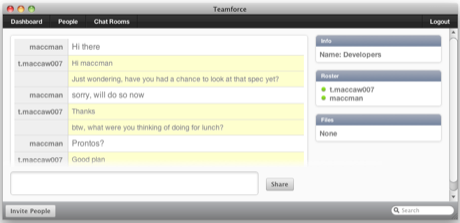fog is a Ruby gem by Wesley Beary to control a variety of cloud services through a unified API. It deals with both server cloud and storage based services and supports Amazon S3 and Rackspace Files; as well as servers and on Amazon EC2, Rackspace Servers, Terremark vCloud and Slicehost. Support is also available for Amazon ELB and SimpleDB.
The beauty of fog is how the same code interacts with different cloud services. It uses models, an idea familiar to anyone who has used an object mapper (like ActiveRecord), to abstract the common parts between cloud services. That leads to code that you can switch between cloud services easily. Read More

This is a great idea. It’s still a couple of months way, but on whyday.org you can sign up for more updates, or you can follow @celebratewhyday on Twitter.
If you want to reminisce in the meantime, Ruby Inside’s link-packed A Cup Full of Why: 32 Why The Lucky Stiff Links will get you started. Read More

The tenth RubyConf has been announced. It’ll be in New Orleans, LA between November 11-13, 2010. You can’t register yet, but there’s a button to book a room at the official hotel.
Considering how quickly RubyConf sometimes sells out, it’s worthwhile following @rubyconf on Twitter to be sure to catch when registration opens in case I don’t let you know quickly enough..! Read More
Giles Bowkett – Ruby Inside’s Top Presenter of 2008 – contributes a guest post:
I created a 90-minute video called How To Get A Kickass Job, Making Six Figures Working (From Home) With The Stars Of Your Community, Even If You Just Got So Fired That The Cops Hauled You Out Of The Building In Handcuffs. Part of my magic formula includes understanding Google PageRank, and the best way to understand complex, abstract mathematics is to reduce them to a very short Ruby script. As an aside, you’d be surprised how many complex, abstract theoretical thingamajigs can condense down to just a few lines of easily understandable Ruby. Read More
Simone’s library public_suffix_service makes it easy to parse any domain name into its TLD, unique domain name, and subdomain portions, following the myriad of rules regarding all of the different TLDs that currently exist. Read More
Clojure, a dialect of Lisp, seems neat, but I can’t get over the endless sea of parentheses. It’s a shame a less noisy approach hasn’t come to the fore. If Clojure floats your boat, though, check out Peepcode’s Functional Programming with Clojure screencast. Read More
An interesting experiment with EventMachine. The number of minor Ruby webapp frameworks has now hit triple digits :-) Read More
DHH gives an insightful and accessible 38 minute walkthrough of some of Rails 3′s differences from Rails 2.0 and explains the motivations behind them. A particular focus is given to improvements made to the routing system (both for REST and non-REST URLs).
I’ve been a bit lukewarm on Rails lately, opting instead to strongarm Sinatra into doing whatever I want, but DHH’s keynote is a compelling overview that encourages me to give it a fair look.
The final release of Rails 3.0 is expected within the next few weeks, with a release candidate in the next week or so. Read More
DataMapper, one of the best known Ruby ORMs (Object Relational Mapper), has reached a significant landmark: version 1.0. DataMapper is typically competing against ActiveRecord and Sequel amongst Ruby developers who want to talk to databases, but DM offers a number of unique advantages and is extremely flexible and modular (even supporting Redis-based stores). Read More
I don’t know how fast Brian’s balls are, but I could escape the jQuery source code (about 164KB) about 1000 times per second on my iMac and that seems pretty fast. It was also very easy to install on OS X (everything is done with a gem install escape_utils).
Brian claims his C-backed library is 10-20x faster than existing Ruby-based escaping techniques for HTML and 16-30x faster for JavaScript. Read More

Rails activist Gregg Pollack (of Ruby5 and RailsEnvy fame) has put together several new screencasts highlighting new Rails 3 features for the official Rails homepage. They’re all about 10 minutes long and cover topics like Action Dispatch, Action Mailer, Bundler, JavaScript integration and Action Controller. Read More

Alex has clearly put a ton of effort into this. Despite being cross-platform, though, don’t get too excited if you plan to target Windows.
An interesting by-product of Bowline is rbyte, a Ruby 1.9.(1|2) library that “compiles” Ruby 1.9 source down to byte code and makes it easy to reload and use said code. Read More
Tonight, Ruby Inside has changed for the better. If you’re reading on the Web, it will be immediately apparent, but if you’re reading via the feed, check out RubyInside.com. Ruby Inside is no longer a magazine-style blog – it’s a Daring Fireball-style tumblelog.
Why?
If you’ve been following Ruby Inside for a year or more, you might have noticed a severe slowdown in posts here over the last several months. This was down to a combination of being busy working on my startup, coder.io, and, frankly, being a bit burnt out writing posts every day for Ruby Inside. Read More
 The latest installment of my series of roundup posts, covering some of my latest findings in the world of all things Ruby. Why two “tidbits” posts in a row? Well, I’m radically redesigning/reworking Ruby Inside to be more interesting, both to you and me. This coupled with work on my new startup coder.io have reduced my available time a lot but, rest assured, everything will be crazy on Ruby Inside again within a week or so :-)
The latest installment of my series of roundup posts, covering some of my latest findings in the world of all things Ruby. Why two “tidbits” posts in a row? Well, I’m radically redesigning/reworking Ruby Inside to be more interesting, both to you and me. This coupled with work on my new startup coder.io have reduced my available time a lot but, rest assured, everything will be crazy on Ruby Inside again within a week or so :-)
For now, enjoy!
DataMapper 1.0.0 RC3 Released
The third release candidate of popular Ruby ORM DataMapper has been released. I’ve become a bit of a MongoMapper and Redis guy myself lately, but ORMs like DataMapper and Sequel provide great alternatives to the ever-popular ActiveRecord ORM. Read More







